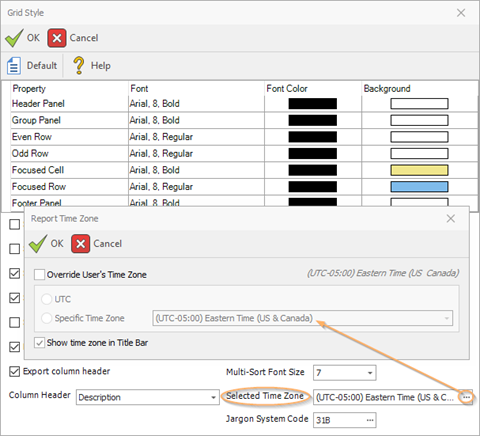Customize the Look, Colors, and Behaviors of Your Report
You can change the look of your layout by clicking Design > Grid Styles...

| To | Do this |
|---|---|
| Change the Font, Font Color or Background of the available styles | Click on the Font, Font Color, or Background of any cell to modify the property. |
| Hide/show vertical lines in your grid | Uncheck/check Show Vertical Lines. |
| Hide/show horizontal lines in your grid | Uncheck/check Show Horizontal Lines. |
| Hide/show summaries in your grid | Uncheck/check Summaries. |
| Place summaries on the same line as your group label (default) | Check Summary on group line. |
| Force report to sort data at the database | Check Sort at Database. This option is for advanced users only. If the Administrator denies this privilege to you, this check box will have no effect. |
| Hide column headers when exporting a report to CSV, XLS, or other format | Uncheck Export Column Headers |
| Fit column widths automatically after each Find | Check Auto-Width On Find. |
| Keep your manual column widths intact | Uncheck Auto-Width On Find. |
| Let Data Access Studio automatically control the character casing for filters | Check Auto-Uppercase Filters. |
| Hide/show the row indicator column at the left | Uncheck/check Show row indicator. |
Hide/show the calculation indicator  in the column header in the column header |
Uncheck/check Show calculation indicator |
| Enable/disable Smart Column Filters | Uncheck/check Smart Column Filters |
| Select a different Column Header type | Click the Column Header options box and select the option you want to see. |
| Hide the sort order numbers in the column headers of the sorted columns. | Uncommon. Set the Multi-Sort Font Size setting to zero. |
| Set the report's time zone to something different from the user's time zone or display the report's time zone in the title bar | Select the ellipsis on the Selected Time Zone setting. |
| Change the JDE module specific naming of columns | Select a different system code (i.e. module identification) for the 'Jargon System Code' setting. Clearing this setting will use the default column headings as defined by the data dictionary. |
Smart Column Filters
Several calculation will automatically add filters to the report to improve performance. Sometimes this performance optimization can interfere with report development and debugging. Following is a list of calculations that leverage Smart Column Filtering.
Tip
Disabling Smart Column Filters can help diagnose issues in complex reports.
| Calculation | Effect of Smart Column Filtering |
|---|---|
| Relative Period | Automatically add fiscal year and period to the query |
| Relative Date | Automatically add known date range to the query |
| List | Automatically add Rollup Criteria to the query |
| Parent/Child | Automatically filter data based on configured root node |
| Model Account | Ensures that the F0901 inclusion in the report is considered a LEFT OUTER join. In other words, non-primary F0901 columns have 'OR <BLANK>' added to their filters. |
The Smart Column Filter setting also controls adding the general 'OR <BLANK>' filter to the columns of the secondary table of all standard LEFT OUTER joins. JDE also uses 'OR <BLANK>' filtering of secondary table columns as well in the query sent to the database that this setting will not control. This setting - if disabled - might then filter records out of the final set of records seen in the report.
Report Time Zone
By default, JDEUTIME columns display time using the time zone and optional daylight savings rule using the user's settings from User Preferences. Normally, this is fine but there are times when a special report is required to view time data from a specific time zone.

To override the user's default time zone, check the Override User's Time Zone checkbox and select either UTC or the Specific Time Zone. For convenience, the current user's default time zone is displayed to the right of the Override User's Time Zone checkbox in italics.
This time zone will be considered the Report's Time Zone. This time zone will be used for:
- Displaying the date/time data in JDEUTIME columns
- Used by the Convert Time calculation
- Used to resolve the TODAY and NOW variables.